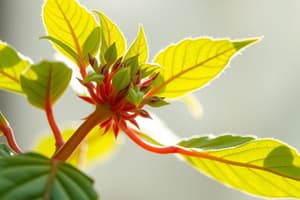Podcast
Questions and Answers
What are the two main stages of photosynthesis?
What are the two main stages of photosynthesis?
- Chlorophyll reactions and Electron transport reactions
- Thylakoid reactions and Stroma reactions
- Light-dependent reactions and Dark reactions
- Light-dependent reactions and Calvin cycle (correct)
Which molecule is produced as a byproduct of the light-dependent reactions?
Which molecule is produced as a byproduct of the light-dependent reactions?
- ATP
- Oxygen (correct)
- Carbon Dioxide
- NADPH
Where do the light-independent reactions occur within the chloroplast?
Where do the light-independent reactions occur within the chloroplast?
- Grana
- Cytoplasm
- Stroma (correct)
- Thylakoid membranes
What is the role of RuBisCO in the Calvin cycle?
What is the role of RuBisCO in the Calvin cycle?
What happens to photosynthesis beyond a certain light intensity?
What happens to photosynthesis beyond a certain light intensity?
Which factor does not affect the efficiency of photosynthesis?
Which factor does not affect the efficiency of photosynthesis?
What is the 3-carbon molecule produced during the Calvin cycle?
What is the 3-carbon molecule produced during the Calvin cycle?
How does temperature affect photosynthesis?
How does temperature affect photosynthesis?
Flashcards
Photosynthesis
Photosynthesis
The process where plants use sunlight to make food from carbon dioxide and water, releasing oxygen.
Light-dependent reactions
Light-dependent reactions
Stage of photosynthesis where sunlight is used to create energy-carrying molecules (ATP and NADPH).
Light-independent reactions
Light-independent reactions
Stage of photosynthesis that uses ATP and NADPH to convert carbon dioxide into sugars (like glucose).
Chlorophyll
Chlorophyll
Signup and view all the flashcards
Carbon fixation
Carbon fixation
Signup and view all the flashcards
ATP
ATP
Signup and view all the flashcards
Food production (photosynthesis)
Food production (photosynthesis)
Signup and view all the flashcards
Factors affecting photosynthesis
Factors affecting photosynthesis
Signup and view all the flashcards
Study Notes
Introduction to Photosynthesis
- Photosynthesis is the process by which green plants and some other organisms use sunlight to synthesize foods from carbon dioxide and water.
- It's a fundamental process for life on Earth, producing oxygen as a byproduct.
- The process occurs in chloroplasts, specialized organelles within plant cells.
Stages of Photosynthesis
- Photosynthesis primarily involves two main stages: light-dependent reactions and light-independent reactions (Calvin cycle).
Light-Dependent Reactions
- These reactions occur in the thylakoid membranes of chloroplasts.
- Sunlight is absorbed by chlorophyll and other pigments, which initiate the process.
- Water is split, releasing oxygen as a byproduct and providing electrons for the electron transport chain.
- Energy from sunlight is converted into chemical energy, primarily in the form of ATP (adenosine triphosphate) and NADPH.
- These energy-carrying molecules are crucial for the subsequent light-independent reactions.
Light-Independent Reactions (Calvin Cycle)
- These reactions occur in the stroma of chloroplasts.
- ATP and NADPH generated in the light-dependent reactions provide the energy and reducing power necessary for this stage.
- Carbon dioxide from the atmosphere is incorporated into an existing 5-carbon molecule called RuBP.
- This process, known as carbon fixation, is catalyzed by the enzyme RuBisCO.
- Through a series of reactions, a 3-carbon molecule (G3P) is formed.
- Some G3P molecules are used to produce glucose and other sugars; the rest are recycled to regenerate RuBP, continuing the cycle.
Factors Affecting Photosynthesis
- Light intensity: Photosynthesis increases with increasing light intensity to a certain point, then plateaus. Beyond a certain intensity it is unaffected.
- Carbon dioxide concentration: Increasing carbon dioxide concentration typically increases photosynthesis until a certain point.
- Temperature: Photosynthesis efficiency is affected by temperature, with an optimum temperature range. Extreme temperatures can hinder the process.
- Water availability: Water is a crucial reactant in photosynthesis. Water scarcity drastically affects photosynthesis rates.
Importance of Photosynthesis
- Food production: Photosynthesis is the primary source of food for most organisms. Plants produce food that's consumed by animals, fungi and many other organisms.
- Oxygen production: Photosynthesis releases oxygen into the atmosphere, which is essential for respiration in most living organisms.
- Maintaining atmospheric balance: Forests and oceans teeming with photosynthetic organisms help balance atmospheric levels of carbon dioxide and oxygen.
Types of Photosynthesis
- C3 photosynthesis is the most common pathway that utilizes RuBisCO.
- C4 photosynthesis, found in some plants, avoids photorespiration under high temperatures and light intensities by concentrating carbon dioxide around RuBisCO.
- CAM (Crassulacean Acid Metabolism) photosynthesis is an adaptation in desert plants that opens stomata at night to take up carbon dioxide, minimizing water loss while still performing photosynthesis.
Studying That Suits You
Use AI to generate personalized quizzes and flashcards to suit your learning preferences.



